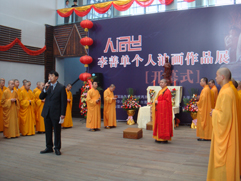
 |
| "The Human Realm - Lee Sun-Don's Totemic Energy Oil Painting" is organized by China Oil Painting Society as the base for exhibitions of artworks by artists of both sides of Taiwan Straits, the Art School of Xiamen University, and the Nanputuo Temple in Xiamen. The exhibition began with a "Blessing Ceremony" specially arranged by Director Yi-Min Lee of the Gallery of China Profiles, Xiamen, China, in the exhibition grand opening, April 26, 2008. The "Blessing Ceremony" was performed by Buddhist Master Ze-Wu of Nanputuo Temple, leading fifty monks and the distinguished guests. Nanputuo Temple is well-known in the south of Fukien and China as "The Temple of a Millennium History", located at the foot of the |  Photo1: Director Yi-min Lee of Gallery of China Profiles, Xiamen announced the Blessing Ceremony. |
| Wulaofeng, and next to Xiamen University. As one of the four most reputed Buddhist temples in China, Nanputao Temple worships mainly Guanyin Bodhisattva, and has gotten its name for being in the south (Nan) side of the Putao Mountain. Nanputao Temple was built in Tang Dynasty, demonstrating the | |
 Photo2:Professor Lee and the distinguished guests moved forward to burn the incense for blessing. |
lasting history and culture through the Hall of Heavenly Kings, the Mahavira Hall, the Mahakaruna Hall, the Sutra Pavilion and Dharma Hall. Along the side are the Bell Tower and Drum Tower, the Zen Room, the Guest Room, the Storage Room, as well as Dean of the Minnan Budhdist College, the Buddhist Zen Exercise Yard. Before the temple is the Setting-life-free Pond and behind the temple is the newly established Monument in honor of Master Taixu. The Temple looks magnificent in appearance and artistic in structure. With halls and rooms decorated with delicate engravings and paintings, and the roofs covered with yellow tiles and crystals, the building of the temple is brilliant, inspiring, and stately. |
| The Sutra Pavilion and Dharma Hall has a valuable collection of Buddha statues of Burma Jade, the antique timepieces from Sung Dynasty, incense burners, bronze Guanyin statue with eight heads and twenty four arms from Ming Dynasty, the porcelain statue of the living Buddha Ji Gong in Qing Dynasty, | |
| and the huge volumes of Buddhist scriptures. The collection also includes copies of the Qisha Tripitaka and the Kalavinka Tripitaka from Sung Dynasty, and a copy in 13520 scrolls of the Taisho Tripitaka from Japan, a re-edited version of the Chinese Tripitaka dating from the Ming Dynasty. The copy of Sutra Pavilion by Monk Xingxu written with his own blood during the years of Chongzhen’s reign of Ming Dynasty, a manuscript of the Amitabha Sutra by Master Hongyi are also part of the collection. In the Wulaofeng behind the temple situates the tomb tower in memory of all the eminent monks of the temple, the Bi Sping, Prajna Pond, Karma-cleansing Cave, Tuslita Yard, Sumati Pavilion, the Aranna Pavilion, Taixu Pavilion, and many more |
 Photo3: The Blessing Ceremony was performed by Buddhist Master Ze-Wu of Nanputuo Temple. |
| scenic spots. The Dean of the Minnan Budhdist College in the Temple was established in 1925, known to be the cradle for future preaching talents and Buddhist monks. The famous vegetarian recipe of the Puzhao Hall Chamber is the sublime in culinary culture. |